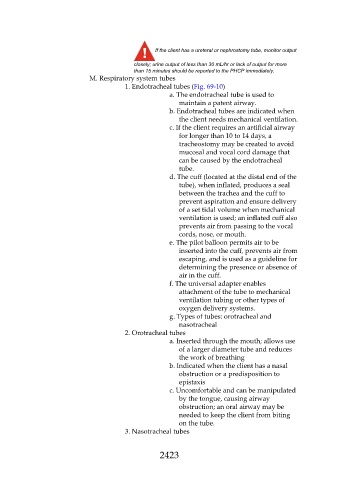Page 2423 - Saunders Comprehensive Review For NCLEX-RN
P. 2423
If the client has a ureteral or nephrostomy tube, monitor output
closely; urine output of less than 30 mL/hr or lack of output for more
than 15 minutes should be reported to the PHCP immediately.
M. Respiratory system tubes
1. Endotracheal tubes (Fig. 69-10)
a. The endotracheal tube is used to
maintain a patent airway.
b. Endotracheal tubes are indicated when
the client needs mechanical ventilation.
c. If the client requires an artificial airway
for longer than 10 to 14 days, a
tracheostomy may be created to avoid
mucosal and vocal cord damage that
can be caused by the endotracheal
tube.
d. The cuff (located at the distal end of the
tube), when inflated, produces a seal
between the trachea and the cuff to
prevent aspiration and ensure delivery
of a set tidal volume when mechanical
ventilation is used; an inflated cuff also
prevents air from passing to the vocal
cords, nose, or mouth.
e. The pilot balloon permits air to be
inserted into the cuff, prevents air from
escaping, and is used as a guideline for
determining the presence or absence of
air in the cuff.
f. The universal adapter enables
attachment of the tube to mechanical
ventilation tubing or other types of
oxygen delivery systems.
g. Types of tubes: orotracheal and
nasotracheal
2. Orotracheal tubes
a. Inserted through the mouth; allows use
of a larger diameter tube and reduces
the work of breathing
b. Indicated when the client has a nasal
obstruction or a predisposition to
epistaxis
c. Uncomfortable and can be manipulated
by the tongue, causing airway
obstruction; an oral airway may be
needed to keep the client from biting
on the tube.
3. Nasotracheal tubes
2423

